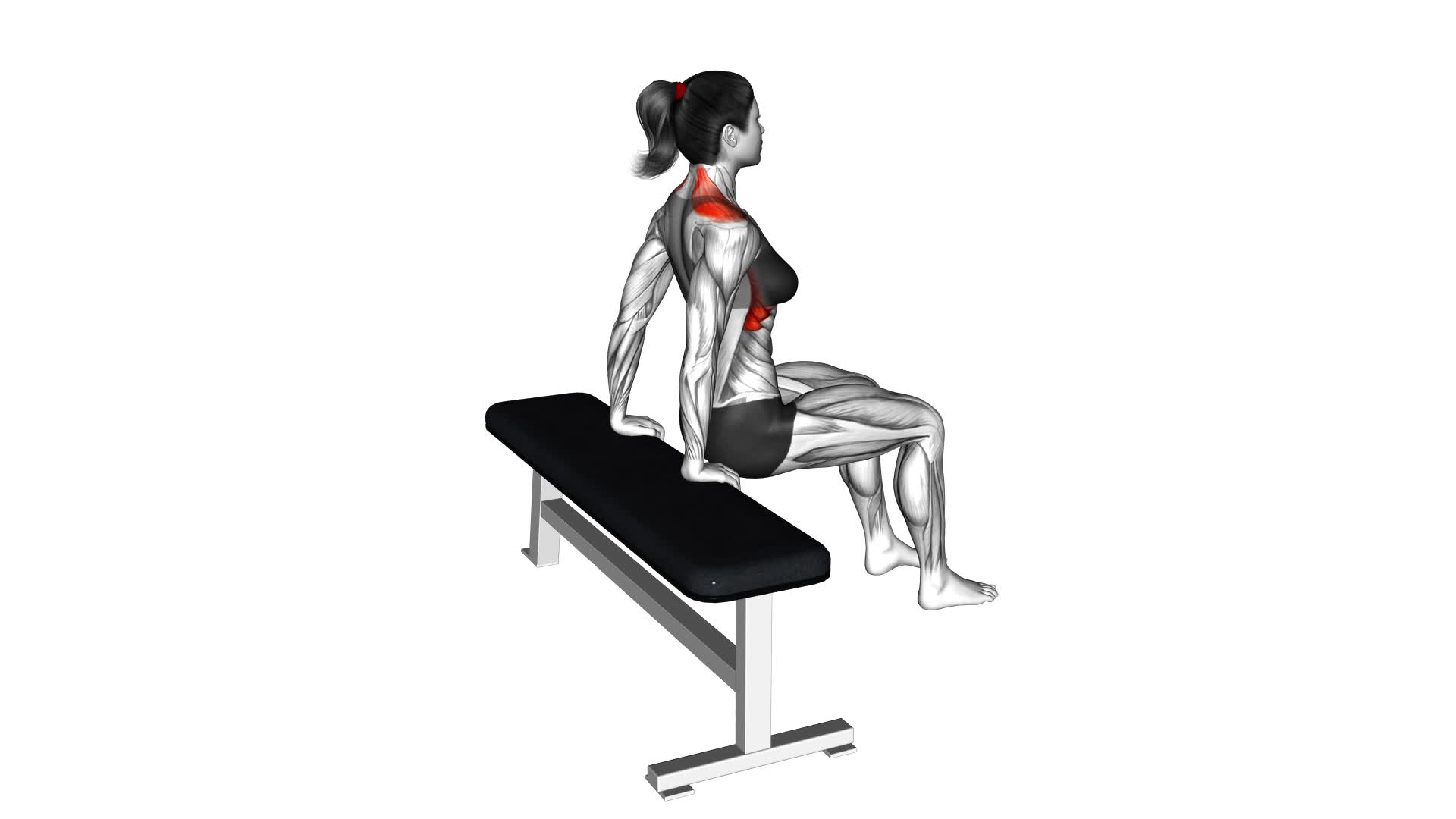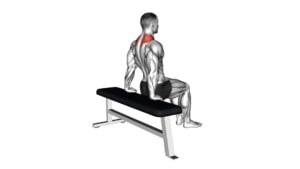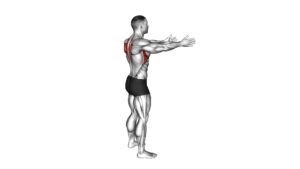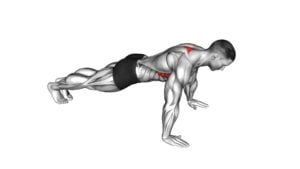Scapula Dips (female) – Video Exercise Guide & Tips

Are you looking for a challenging upper body exercise that targets your scapula muscles? Look no further than scapula dips!
Watch This Exercise Video
In this video exercise guide, we'll walk you through the proper form and technique for scapula dips, while providing tips to avoid common mistakes.
We'll also share modifications and safety precautions specifically for females.
So grab your mat and get ready to strengthen those scapula muscles with this effective exercise.
Let's dive in!
Key Takeaways
- Scapula dips can improve upper body strength in females.
- They target muscles in the shoulders, arms, and back.
- Scapula dips can enhance overall upper body strength and performance in other exercises.
- Proper form and technique, as well as avoiding common mistakes, are important for effective scapula dips.
Benefits of Scapula Dips for Females
You will experience significant improvements in upper body strength and shoulder stability through incorporating scapula dips into your exercise routine. Scapula dips are an effective exercise that specifically targets the muscles in your shoulders and upper back.
For women, there are several key benefits to incorporating scapula dips into your workout regimen.
One of the main benefits of scapula dips for women is improved upper body strength. This exercise targets the muscles in your shoulders, arms, and back, helping to build strength and tone in these areas. By regularly performing scapula dips, you can increase your overall upper body strength and improve your ability to perform other exercises.
In addition to strength, scapula dips also help to improve shoulder stability. This is especially important for women, as they're more prone to shoulder injuries compared to men. By strengthening the muscles around your shoulder blades, scapula dips can help to stabilize your shoulders and reduce the risk of injuries.
It is worth noting that scapula dips can be modified to suit different fitness levels and abilities. If you're a beginner, you can start by performing the exercise with your knees bent and feet on the ground. As you become more comfortable and stronger, you can progress to performing scapula dips with your legs straight and feet elevated on a bench or step.
Equipment Needed for Scapula Dips
To perform scapula dips effectively, there are a few essential pieces of equipment you'll need. These include parallel bars or dip bars, which provide stability and support for your body during the exercise.
If you don't have access to these, you can also use sturdy chairs or elevated surfaces as alternatives.
Essential Equipment for Scapula Dips
To perform scapula dips, you'll need just one piece of essential equipment: a dip bar or parallel bars. These bars are usually found in a gym or can be purchased for home use.
Scapula dips are a highly effective exercise for females as they target the muscles in the upper body, particularly the triceps, shoulders, and upper back. By strengthening these muscles, scapula dips can improve posture, increase upper body strength, and enhance overall fitness.
If you don't have access to dip bars, there are alternatives you can try. For example, you can use two sturdy chairs placed parallel to each other, or even the edge of a sturdy table or countertop. Just make sure whatever alternative you use is stable and can support your body weight.
Alternatives to Required Equipment
If you don't have access to dip bars, there are alternatives you can try using for scapula dips. Bodyweight exercises can be a great option for home workouts.
One alternative is using a sturdy table or chair. Place your hands on the edge of the table or chair, fingers pointing forward, and lower and raise your body in a controlled manner.
Another option is using parallel bars, if available. These can be found at some parks or fitness facilities. Simply grip the bars with your hands, extend your legs, and lower yourself down by bending your elbows. Remember to engage your scapulae throughout the movement.
With these alternatives, you can still perform scapula dips and work your upper body muscles effectively.
Proper Form and Technique for Scapula Dips
Start by positioning your body in a stable and upright position.
Scapula dips are a great exercise for targeting the muscles of the upper back and shoulders.
To perform scapula dips, begin by gripping a parallel bar with your hands shoulder-width apart. Keep your body straight and your feet off the ground, with your arms fully extended.
Lower your body by retracting your shoulder blades and bending your elbows, keeping your elbows close to your body. Go as low as you can without compromising form, then push back up to the starting position by protracting your shoulder blades and extending your elbows.
This exercise can be modified and progressed in various ways to challenge your muscles even more.
For scapula dip variations, you can try using rings instead of parallel bars or using a dip station with angled bars.
To progress the exercise, you can add weight by using a dip belt or wearing a weighted vest.
Remember to always maintain proper form and technique to maximize the effectiveness of the exercise and prevent injury.
Common Mistakes to Avoid During Scapula Dips
To perform scapula dips correctly, it's important to maintain proper shoulder alignment. Make sure to keep your shoulders down and back, avoiding any shrugging or hunching.
Engaging your core muscles throughout the exercise will also help you maintain stability and prevent any excessive movement.
Proper Shoulder Alignment
You need to ensure that your shoulders are properly aligned to avoid common mistakes during scapula dips. Proper shoulder alignment is crucial for maintaining shoulder stability and optimizing scapula mobility during this exercise.
To achieve proper alignment, start by retracting and depressing your shoulder blades, pulling them down and back towards your spine. This activates the muscles responsible for stabilizing your shoulders and helps prevent excessive shoulder joint movement and potential injury.
Additionally, keep your shoulders relaxed and away from your ears, avoiding any shrugging or tension. By maintaining proper shoulder alignment, you can perform scapula dips with better control and reduce the risk of strain or discomfort in your shoulders.
Engaging Core Muscles
Maintain proper engagement of your core muscles to avoid common mistakes during scapula dips. Proper engagement of your core muscles is crucial for performing scapula dips correctly and preventing injury.
Here are some common mistakes to avoid and tips for engaging your core muscles effectively:
- Avoid arching your lower back: Keep your spine in a neutral position and engage your abdominal muscles to prevent excessive arching of the lower back.
- Don't let your shoulders collapse: Maintain proper shoulder alignment by retracting and depressing your scapulae, keeping them stable and engaged throughout the movement.
- Avoid relying solely on your arms: Engage your core muscles to provide stability and support during scapula dips, instead of relying solely on your arm strength.
- Don't hold your breath: Breathe naturally throughout the exercise to maintain proper engagement of your core muscles and enhance overall performance.
Avoiding Excessive Shoulder Shrugging
Avoid excessive shoulder shrugging by keeping your scapulae stable and engaged throughout the scapula dips exercise.
Proper scapula engagement is essential for maintaining shoulder stability and preventing unnecessary strain on your shoulder joints.
When performing scapula dips, focus on retracting and depressing your shoulder blades, pulling them down and towards your spine.
This will help to activate the muscles in your upper back and provide a stable foundation for your shoulders.
Avoid allowing your shoulders to shrug up towards your ears, as this can lead to tension and discomfort.
Tips to Increase the Difficulty of Scapula Dips
To make Scapula Dips more challenging, consider incorporating variations that target different muscle groups. Here are some tips to increase the difficulty of Scapula Dips:
- Add weight: Hold a dumbbell or a weight plate between your feet or wear a weighted vest to increase the resistance and make the exercise more challenging.
- Elevate your feet: Place your feet on an elevated surface, such as a bench or step, to increase the range of motion and engage your muscles more intensely.
- Use gymnastic rings: Performing Scapula Dips on gymnastic rings requires more stability and control, making it a more advanced variation of the exercise.
- Increase the tempo: Instead of performing slow and controlled movements, try doing Scapula Dips at a faster pace. This will challenge your muscles and cardiovascular system.
By incorporating these variations, you can progressively increase the difficulty of Scapula Dips and continue to challenge your muscles as you get stronger.
However, it's important to remember to maintain proper form and listen to your body to avoid injury.
Now, let's move on to discussing the safety precautions and modifications for Scapula Dips.
Safety Precautions and Modifications for Scapula Dips
Before attempting Scapula Dips, it's important to ensure proper form and listen to your body's cues to prevent injury. Safety modifications can be implemented to ensure a safe and effective workout.
First, make sure that the surface you're performing the exercise on is stable and secure. This will help prevent any accidents or falls during the exercise.
Additionally, it's important to use caution when performing Scapula Dips if you have any pre-existing shoulder or wrist injuries. Modify the exercise by reducing the range of motion or using assistance, such as a resistance band, to decrease the strain on the injured areas.
It's also important to warm up properly before attempting Scapula Dips to increase blood flow to the muscles and reduce the risk of injury.
Lastly, always listen to your body's cues during the exercise. If you experience any pain or discomfort, stop immediately and consult a healthcare professional.
Frequently Asked Questions
How Many Calories Can I Burn by Doing Scapula Dips?
You can burn calories and improve your posture by doing scapula dips.
Scapula dips are a effective exercise that targets the muscles in your upper back and shoulders. By engaging these muscles, you can increase your caloric burn and promote better posture.
The exact number of calories burned will vary depending on factors such as your weight, intensity of the exercise, and duration. However, incorporating scapula dips into your workout routine can definitely contribute to your overall calorie burn.
Can Scapula Dips Help Improve My Posture?
Scapula dips can be beneficial for improving your posture. By targeting the muscles around your shoulder blades, scapula dips help strengthen and stabilize your upper back. This can lead to better alignment and reduced slouching.
Compared to other exercises, scapula dips specifically target the muscles responsible for maintaining good posture. Incorporating them into your workout routine can be a great way to improve your overall posture and prevent common postural issues.
How Often Should I Incorporate Scapula Dips Into My Workout Routine?
To incorporate scapula dips into your workout routine, it's important to consider the frequency and timing.
Scapula dips can be done 2-3 times per week, allowing for adequate rest and recovery.
As for the best time to do them, it's recommended to perform scapula dips at the beginning or middle of your upper body workout.
This way, you can engage the targeted muscles effectively while still having enough energy to complete the exercise with proper form.
Can Scapula Dips Help With Reducing Back Pain?
Scapula dips can be beneficial for reducing back pain. By incorporating scapula dips into your workout routine, you can improve shoulder mobility and strengthen your upper back. These exercises target the muscles around the scapula, helping to stabilize and support your spine. When performed correctly and consistently, scapula dips can contribute to a healthier back and potentially alleviate discomfort.
Always consult with a healthcare professional before starting any new exercise program, especially if you have existing back pain.
Are Scapula Dips Suitable for Beginners or Should I Have Prior Upper Body Strength?
Scapula dips can be suitable for beginners, even if you don't have prior upper body strength. They're a great exercise to strengthen your shoulder muscles and improve posture.
If you're just starting out, you can modify the exercise by using a bench or chair for support. As you progress, you can gradually increase the difficulty by using a lower support or adding weights.
If scapula dips feel too challenging, there are alternative exercises like push-ups or shoulder presses that you can try.
Conclusion
In conclusion, scapula dips are a beneficial exercise for females looking to strengthen their upper body and improve posture. By using proper form and technique, and avoiding common mistakes, women can effectively target their scapular muscles.
To increase the difficulty of scapula dips, adding resistance or performing variations can be helpful. It's important to prioritize safety and modify the exercise if needed.
Incorporating scapula dips into a regular workout routine can lead to improved strength and overall fitness for females.

Author
Years ago, the spark of my life’s passion ignited in my mind the moment I stepped into the local gym for the first time. The inaugural bead of perspiration, the initial endeavor, the very first surge of endorphins, and a sense of pride that washed over me post-workout marked the beginning of my deep-seated interest in strength sports, fitness, and sports nutrition. This very curiosity blossomed rapidly into a profound fascination, propelling me to earn a Master’s degree in Physical Education from the Academy of Physical Education in Krakow, followed by a Sports Manager diploma from the Jagiellonian University. My journey of growth led me to gain more specialized qualifications, such as being a certified personal trainer with a focus on sports dietetics, a lifeguard, and an instructor for wellness and corrective gymnastics. Theoretical knowledge paired seamlessly with practical experience, reinforcing my belief that the transformation of individuals under my guidance was also a reflection of my personal growth. This belief holds true even today. Each day, I strive to push the boundaries and explore new realms. These realms gently elevate me to greater heights. The unique combination of passion for my field and the continuous quest for growth fuels my drive to break new ground.







